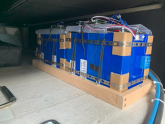Ampster
Renewable Energy Hobbyist
I am thinking the same way. I decided to use aluminum because infrared heat photos of other prismatics showed a lot of heat around the terminals and aluminum is a better heat conductor than copper. The 1/4 inch thickness should make up for the lower electrical conductivity.My plan is to use 1/4" 6061-T6 aluminum plate with threaded rod and a Lucite top
I haven't decided on the Lucite yet because mine are in a metal cabinet with lockable doors.



